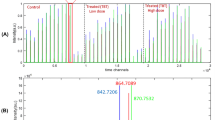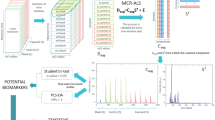Abstract
Cyanobacteria are a group of photosynthetic, nitrogen-fixing bacteria present in a wide variety of habitats such as freshwater, marine, and terrestrial ecosystems. In this work, the effects of As(III), a major toxic environmental pollutant, on the lipidomic profiles of two cyanobacteria species (Anabaena and Planktothrix agardhii) were assessed by means of a recently proposed method based on the concept of regions of interest (ROI) in liquid chromatography mass spectroscopy (LC-MS) together with multivariate curve resolution alternating least squares (MCR-ALS). Cyanobacteria were exposed to two concentrations of As(III) for a week, and lipid extracts were analyzed by ultrahigh-performance liquid chromatography/time-of-flight mass spectrometry in full scan mode. The data obtained were compressed by means of the ROI strategy, and the resulting LC-MS data sets were analyzed by the MCR-ALS method. Comparison of profile peak areas resolved by MCR-ALS in control and exposed samples allowed the discrimination of lipids whose concentrations were changed due to As(III) treatment. The tentative identification of these lipids revealed an important reduction of the levels of some galactolipids such as monogalactosyldiacylglycerol, the pigment chlorophyll a and its degradation product, pheophytin a, as well as carotene compounds such as 3-hydroxycarotene and carotene-3,3′-dione, all of these compounds being essential in the photosynthetic process. These results suggested that As(III) induced important changes in the composition of lipids of cyanobacteria, which were able to compromise their energy production processes.

Steps of the proposed LC-MS + MCR-ALS procedure







Similar content being viewed by others
References
Ferrari SG, Silva PG, González DM, Navoni JA, Silva HJ. Arsenic tolerance of cyanobacterial strains with potential use in biotechnology. Rev Argent Microbiol. 2013;45(03):174–9.
Su S, Zeng X, Feng Q, Bai L, Zhang L, Jiang S, et al. Demethylation of arsenic limits its volatilization in fungi. Environ Pollut. 2015;204:141–4.
Phan K, Sthiannopkao S, Heng S, Phan S, Huoy L, Wong MH, et al. Arsenic contamination in the food chain and its risk assessment of populations residing in the Mekong River basin of Cambodia. J Hazard Mater. 2013;262:1064–71.
Wang Z, Luo Z, Yan C. Accumulation, transformation, and release of inorganic arsenic by the freshwater cyanobacterium Microcystis aeruginosa. Environ Sci Pollut Res. 2013;20(10):7286–95.
Joseph T, Dubey B, McBean EA. A critical review of arsenic exposures for Bangladeshi adults. Sci Total Environ. 2015;527–528:540–51.
de Oliveira VE, Neves Miranda MAC, Soares MCS, Edwards HGM, de Oliveira LFC. Study of carotenoids in cyanobacteria by Raman spectroscopy. Spectrochim Acta A Mol Biomol Spectrosc. 2015;150:373–80.
Yin X-X, Chen J, Qin J, Sun G-X, Rosen BP, Zhu Y-G. Biotransformation and volatilization of arsenic by three photosynthetic cyanobacteria. Plant Physiol. 2011;156(3):1631–8.
Cassier-Chauvat C, Chauvat F. Responses to oxidative and heavy metal stresses in cyanobacteria: recent advances. Int J Mol Sci. 2015;16(1):871.
Vermaas WFJ. Photosynthesis and respiration in cyanobacteria. In: Encyclopedia of life sciences. New York: Wiley; 2001. doi:10.1038/npg.els.0001670.
Chen D, Yan X, Xu J, Su X, Li L. Lipidomic profiling and discovery of lipid biomarkers in Stephanodiscus sp. under cold stress. Metabolomics. 2013;9(5):949–59.
Hölzl G, Dörmann P. Structure and function of glycoglycerolipids in plants and bacteria. Prog Lipid Res. 2007;46(5):225–43.
Dörmann P, Benning C. Galactolipids rule in seed plants. Trends Plant Sci. 2002;7(3):112–8.
Li S, Xu J, Jiang Y, Zhou C, Yu X, Zhong Y, et al. Lipidomic analysis can distinguish between two morphologically similar strains of Nannochloropsis oceanica. J Phycol. 2015;51(2):264–76.
Lima KMG, Bedia C, Tauler R. A non-target chemometric strategy applied to UPLC-MS sphingolipid analysis of a cell line exposed to chlorpyrifos pesticide: a feasibility study. Microchem J. 2014;117:255–61.
Gorrochategui E, Jaumot J, Tauler R. A protocol for LC-MS metabolomic data processing using chemometric tools. Protocol Exchange. 2015. doi:10.1038/protex.2015.102.
Jaumot J, Gargallo R, de Juan A, Tauler R. A graphical user-friendly interface for MCR-ALS: a new tool for multivariate curve resolution in MATLAB. Chemom Intell Lab Syst. 2005;76(1):101–10.
Jaumot J, de Juan A, Tauler R. MCR-ALS GUI 2.0: new features and applications. Chemom Intell Lab Syst. 2015;140:1–12.
Gorrochategui E, Casas J, Porte C, Lacorte S, Tauler R. Chemometric strategy for untargeted lipidomics: biomarker detection and identification in stressed human placental cells. Anal Chim Acta. 2015;854:20–33.
Bedia C, Dalmau N, Jaumot J, Tauler R. Phenotypic malignant changes and untargeted lipidomic analysis of long-term exposed prostate cancer cells to endocrine disruptors. Environ Res. 2015;140:18–31.
Farrés M, Piña B, Tauler R. Chemometric evaluation of Saccharomyces cerevisiae metabolic profiles using LC–MS. Metabolomics. 2015;11(1):210–24.
Grund SS, Hanusch K, Wolf HU. Arsenic and arsenic compounds. Ullmann’s encyclopedia of industrial chemistry. Weinheim: Wiley-VCH; 2005.
Koek MM, Jellema RH, van der Greef J, Tas AC, Hankemeier T. Quantitative metabolomics based on gas chromatography mass spectrometry: status and perspectives. Metabolomics. 2011;7(3):307–28.
Merrill Jr AH, Sullards MC, Allegood JC, Kelly S, Wang E. Sphingolipidomics: high-throughput, structure-specific, and quantitative analysis of sphingolipids by liquid chromatography tandem mass spectrometry. Methods. 2005;36(2):207–24.
Tauler R. Calculation of maximum and minimum band boundaries of feasible solutions for species profiles obtained by multivariate curve resolution. J Chemom. 2001;15(8):627–46.
de Juan A, Jaumot J, Tauler R. Multivariate curve resolution (MCR). Solving the mixture analysis problem. Anal Methods. 2014;6(14):4964–76.
Olson JM, Romano CA. A new chlorophyll from green bacteria. Biochim Biophys Acta. 1962;59(3):726–8.
Rocchetta I, Küpper H. Chromium- and copper-induced inhibition of photosynthesis in Euglena gracilis analysed on the single-cell level by fluorescence kinetic microscopy. New Phytol. 2009;182(2):405–20.
Domonkos I, Kis M, Gombos Z, Ughy B. Carotenoids, versatile components of oxygenic photosynthesis. Prog Lipid Res. 2013;52(4):539–61.
Acknowledgments
The authors would like to acknowledge the financial support from the Brazilian Federal Agency for the Support and Evaluation of Graduate Education (CAPES) and Brazilian National Council for Scientific and Technological Development (CNPq) for a 1-year fellowship to Aline Marques in the Chemometrics Research Group at IDAEA-CSIC, Barcelona, Spain. K.M.G. Lima acknowledges the CNPq Grant (305962/2014-0) for financial support. This work was funded by grants from CNPq/Capes project (grant 070/2012) and by the CHEMAGEB project (FP/2007-2013)/ERC Grant Agreement no. 320737). The authors also thank Dr. Benjamín Piña and Claudia Rivetti (IDEAE/CSIC) for providing the cyanobacteria species control.
Author information
Authors and Affiliations
Corresponding author
Ethics declarations
All authors have accepted the content of this paper and the principles of ethical and professional conduct. Sources of funding are given in the Acknowledgements section. This research has no conflict of interest and has not involved humans or animals
Rights and permissions
About this article
Cite this article
Marques, A.S., Bedia, C., Lima, K.M.G. et al. Assessment of the effects of As(III) treatment on cyanobacteria lipidomic profiles by LC-MS and MCR-ALS. Anal Bioanal Chem 408, 5829–5841 (2016). https://doi.org/10.1007/s00216-016-9695-5
Received:
Revised:
Accepted:
Published:
Issue Date:
DOI: https://doi.org/10.1007/s00216-016-9695-5




